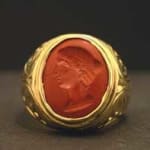Roman Jasper Intaglio of the Bust of a Woman, 200 CE - 400 CE
Jasper-Gold
FJ.6488
The art of glyptics, or carving on colored precious stones, is probably one of the oldest known to humanity. Intaglios, gems with an incised design, were made as early as...
The art of glyptics, or carving on colored precious stones, is probably one of the oldest known to humanity. Intaglios, gems with an incised design, were made as early as the fourth and third millennia BC in Mesopotamia and Aegean Islands. They display a virtuosity of execution that suggests an old and stable tradition rooted in the earliest centuries. The tools required for carving gems were simple: a wheel with a belt-drive and a set of drills. Abrasives were necessary since the minerals used were too hard for a metal edge. A special difficulty of engraving intaglios, aside from their miniature size, was that the master had to work with a mirror image in mind.
In Imperial Rome coins and marble statuary were a means of disseminating the image of a ruler, and consequently seen as very effective propaganda tools. Intaglios were an elite item, worn by wealthy aristocrats and nobles at court. The lovely profile on this fine intaglio closely resembles the empress Faustina Junior, youngest daughter of Antoninus Pius and wife of emperor M. Aurelius (reigned A.D.161 - 180). She is facing left with her hair held in a net, or arranged in braids of a checkerboard pattern. Just as today, elaborate coiffures were expensive and limited to the upper classes who could afford slaves expert in the art of hair design. Her youthful freshness radiates from the warm jasper, bringing alive again a vanished world of royal splendor.
In Imperial Rome coins and marble statuary were a means of disseminating the image of a ruler, and consequently seen as very effective propaganda tools. Intaglios were an elite item, worn by wealthy aristocrats and nobles at court. The lovely profile on this fine intaglio closely resembles the empress Faustina Junior, youngest daughter of Antoninus Pius and wife of emperor M. Aurelius (reigned A.D.161 - 180). She is facing left with her hair held in a net, or arranged in braids of a checkerboard pattern. Just as today, elaborate coiffures were expensive and limited to the upper classes who could afford slaves expert in the art of hair design. Her youthful freshness radiates from the warm jasper, bringing alive again a vanished world of royal splendor.



